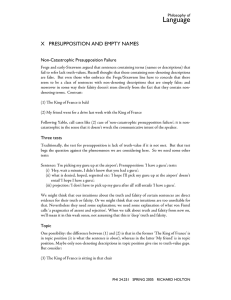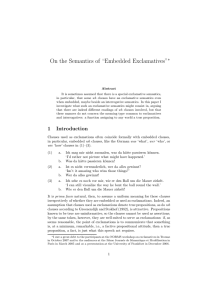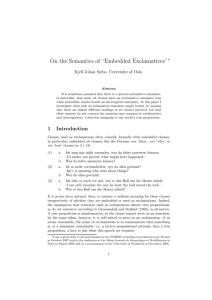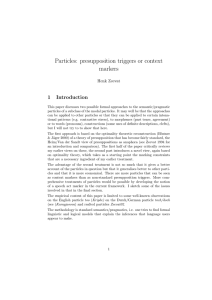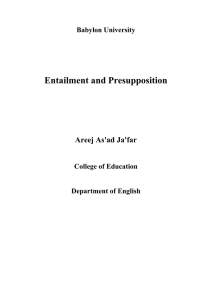On the Semantics of “Embedded Exclamatives” Kjell Johan Sæbø Universitetet i Oslo
advertisement
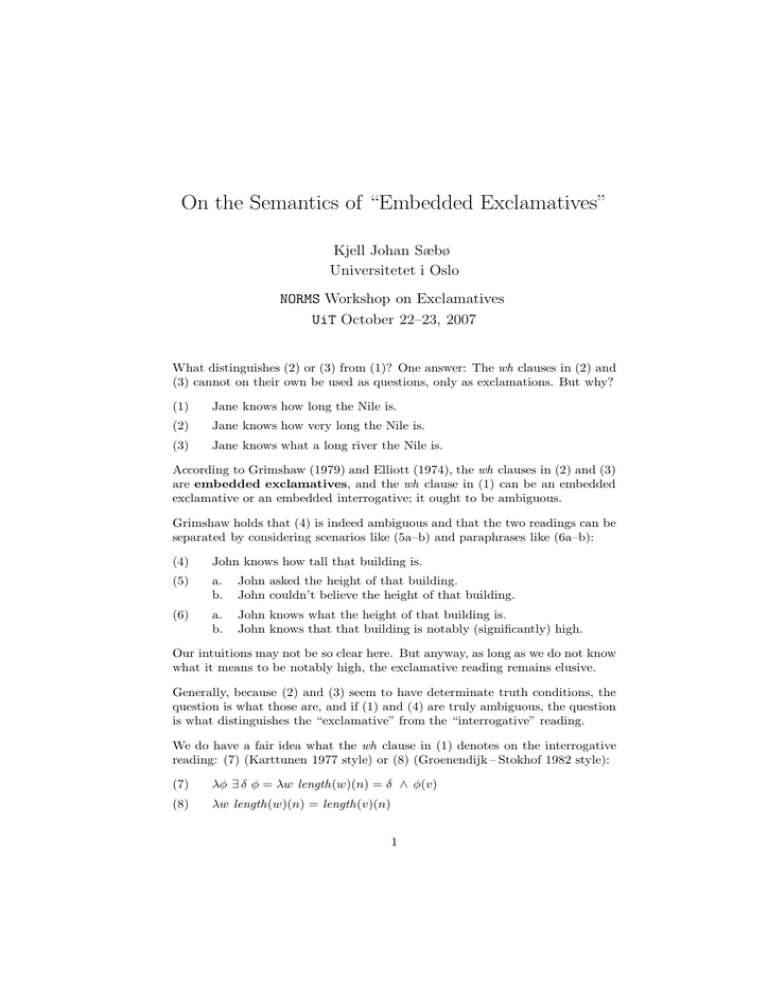
On the Semantics of “Embedded Exclamatives” Kjell Johan Sæbø Universitetet i Oslo NORMS Workshop on Exclamatives UiT October 22–23, 2007 What distinguishes (2) or (3) from (1)? One answer: The wh clauses in (2) and (3) cannot on their own be used as questions, only as exclamations. But why? (1) Jane knows how long the Nile is. (2) Jane knows how very long the Nile is. (3) Jane knows what a long river the Nile is. According to Grimshaw (1979) and Elliott (1974), the wh clauses in (2) and (3) are embedded exclamatives, and the wh clause in (1) can be an embedded exclamative or an embedded interrogative; it ought to be ambiguous. Grimshaw holds that (4) is indeed ambiguous and that the two readings can be separated by considering scenarios like (5a–b) and paraphrases like (6a–b): (4) John knows how tall that building is. (5) a. b. John asked the height of that building. John couldn’t believe the height of that building. (6) a. b. John knows what the height of that building is. John knows that that building is notably (significantly) high. Our intuitions may not be so clear here. But anyway, as long as we do not know what it means to be notably high, the exclamative reading remains elusive. Generally, because (2) and (3) seem to have determinate truth conditions, the question is what those are, and if (1) and (4) are truly ambiguous, the question is what distinguishes the “exclamative” from the “interrogative” reading. We do have a fair idea what the wh clause in (1) denotes on the interrogative reading: (7) (Karttunen 1977 style) or (8) (Groenendijk – Stokhof 1982 style): (7) λφ ∃ δ φ = λw length(w)(n) = δ ∧ φ(v) (8) λw length(w)(n) = length(v)(n) 1 1 How very A Intuition: “How very long it is” presupposes that it is very long. Some natural sentences: (9) Wenn man überlegt, wie enorm tief dieser Fjord ist, wird einem schaurig. (1) Not until . . . have many really thought about how very tall the Bluffton Bluff is in very flat Wells County. (2) Failure to realize how very tall the plants become leads to trees being planted in improper places. Ordinary semantics for very etc. does not permit how to apply to very tall , for how needs a measure function, and very produces a predicate: The Semantics of very according to Katz (2005: 187): [[ very ]] = λP λx∃d [P (x)(d) ∧ d RP dP ∧ d is distant from dP ] This is to be compared to Kennedy’s (2007) theory of the positive as a covert formative severed from the adjective stem (d RP dP corresponds to g(x) ≥ s(g)): The Semantics of pos according to Kennedy (2007: 17): [[ pos ]] = λgλx g(x) ≥ s(g) Here s is a context-sensitive function from measure functions to degrees that returns a standard of comparison based on properties of the adjective g and on features of the context of utterance, “in such a way as to ensure that the objects that the positive form is true of ‘stand out’ in the context of utterance, relative to the kind of measurement that the adjective encodes.” (Kennedy 2007: 17). One way to make very yield a measure function and predict the presupposition is to assume a split positive formative where pos0 relates the measure to the standard of comparison by mapping a measure function coming from a bare adjective, giving a measure, onto a measure function giving the difference between that measure and the standard of comparison, and where pos1 maps a measure function onto a predicate, the set of entities where the measure is positive. The denotations of the relevant words can be represented thus: long ′i = λx long i (x) very ′i = λmλx mi (x) − v pos1 ′i = λmλx mi (x) > 0 pos0 ′i = λmλx mi (x) − Si (m) how 1 ′i = λmλxλj mi (x) = mj (x) The wh semantics is à la Groenendijk and Stokhof. 2 And the semantic composition of the clause “how very long the Nile (is)” is: λj long i (n) − Si (long) − v = long j (n) − Sj (long) − v Q QQ the Nile λxλj long i (x) − Si (long) − v = long j (x) − Sj (long) − v Q QQ ′ how 1 i λx long i (x) − Si (long) − v Q QQ ′ very i λx long i (x) − Si (long) Q Q Q long ′i pos0 ′i Pos0 and very are omissible. Therefore, it must be possible to know how long the Nile is without pos0 – in the first sense – without knowing how long it is with pos0 – in the second sense; it must not be contradictory that Jane knows that the Nile is such and such long, yet she does not know how long it is. As far as asking, not knowing, is concerned, Quine would disagree: “So far as evidence goes, then, our ontology is neutral. Nor let us imagine beyond it some inaccessible reality. The very terms ‘thing’ and ‘exist’ and ‘real’, after all, make no sense apart from human conceptualization. Asking after the thing in itself, apart from human conceptualization, is like asking how long the Nile really is, apart from our parochial miles or kilometers.” (Quine 1993: 113) But it does seem possible to know a measure in the first, absolute sense without knowing it in the second, relative sense: (10) She knew the jump was long, and she knew it measured 5.70 m, but she didn’t know how long it was until the end of the competition. To know wh . . . in the first sense but not in the second sense amounts to not knowing the standard of comparison – having no or a false belief about it. (11) I didn’t realize how much time I used to have until I had James. (12) She didn’t realize how far it was, although she knew it was 40 km and she knew it was far; what she failed to realize was in in those conditions, her threshold for getting tired was at 20 km, not at 30 km. Additional evidence for pos0 : Sometimes necessary for the wh proposition not to be tautologous (absolute measures are world-independent, standards are not): 3 (13) I heard my brother’s voice (the mountaineer) before my trip asking me “Tricia, do you have any idea how high 19.000 feet is?” and my response “I know exactly how high it is!” Ah, the arrogance of the inexperienced climber! I now realized he was right – I had no idea what 19.000 feet felt like, until now. (14) Maybe you don’t know how fast 50 seconds is. Jessica Rett (communication on ongoing work) introduces an optional, covert degree modifier eval resulting in (15), to be compared with (7): (15) λφ ∃ δ φ = λw long(w)(n) = δ ∧ δ > S(long) ∧ φ(v) On Rett’s analysis, (1) may mean that Jane knows (7) or that she knows (15), the degree to which the Nile is long and that it is long relative to a standard. But this seems too weak: (10) or (12) come out as contradictory and (14) comes out as equivalent to (16): (16) Maybe you don’t know that 50 seconds is fast. What accounts for the presupposition that it is very long? With pos0 , the implication that the Nile is (very) long arguably corresponds to the existential presupposition often accompanying wh questions: m(x) > 0. Often, not always (Groenendijk and Stokhof 1997: 1119f., Grønn 2004: 215ff.); but note that without this presupposition, very would be redundant. This accounts for the presupposition. What accounts for the fact that these clauses cannot be questions? By the same token, “how very long it is” reduces to “how long it is” on the pos0 interpretation, in the sense that the same proposition is denoted. What would be appropriate answers to the latter? – very, enormously, extremely, etc.; – long enough to . . . / too long to . . . ; so long that . . . And such an answer is already given by virtue of the presupposition.1 Abels’ marginal “How very . . . ?” cases: The standard is in the common ground, so the proposition is not λj long j (n)−Sj (long)−v = long i (n)−Si (long)−v but λj long j (n)−Sj (long)−v = long i (n)−Sj (long)−v and reduces to λj long i (n) = long j (n), so the answer asked for is the absolute measure – and such an answer is not already given by virtue of the presupposition. 1 Cf.: “Once we treat intensified wh-questions as questions, it is a natural move to treat them as somehow deficient. d’Avis (2001) makes a concrete proposal along these lines. For him they are semantically interrogatives . . . which are deficient in the sense that they presuppose their own answer.” (Abels 2007: 22) 4 2 What a (A) N In (17)–(19), the full positive seems to be involved in the measurement: (17) He knows what a long hike it is home. (18) I learnt what a long process the law is. (19) Most people don’t appreciate what a big country Venezuela is. Intuition: I learnt what a long process the law is means that I learnt to what extent the law is a long process, presupposing that it is indeed a long process. Note that if the noun is intrinsically gradable, no adjective is necessary: (20) . . . , bragging about what a Casanova he is. (21) We all know what a (big) fan of horse racing he is. (22) He even goes out of his way to make sure anyyone reading each entry knows how innocent he is and what a (big) victim he is. Let us assume that this “what” incorporates a partial mapping from predicates to measure functions: what 3 ′i = λP λxλj ∆(P )j (x) = ∆(P )i (x) ∆(P )j (x) reads ‘the degree to which x is P in j’. Interestingly, the same format can be used for gradable event types: (23) Do you remember how it rained that week? (24) See how they run! (Lennon 1968) / See how they shine! (Simon 1969) (25) Don’t you see how (badly) she is shivering? Do something! Note that this how can be both koss/åssen (or som) and kor in Norwegian.2 how 3 ′i = λQλeλj ∆(Q)j (e) = ∆(Q)i (e) ∆(Q)j (e) reads ‘the degree to which e is Q in j’. How can ∆ turn a property into a measure function? Because the property is in turn based on a measure function – it is born one; only in the course of prelexical derivation does it become a property, accepting those x or e that exceed a standard on the relevant scale.3 2 Google: “Variasjoner: tykje – tykje ta – han tykje – eks. han tykje kor det regna (i steden for satan kor han regna)” 3 Paradis (2000) and Morzycki (2006) make suggestions along these lines. 5 Properties born measure functions probably involve, in Kennedy’s (2007) term, ‘lower closed scales’, as do adjectives like dirty or bent , so that (a relative) 0 counts as the standard of comparison. Here is a tree for “what a big diva Justin is”:4 λj ∆(λx diva(x)−b > 0)j (j) = ∆(λx diva(x)−b > 0)i (j) Q QQ Justin λxλj ∆(λx diva(x)−b > 0)j (x) = ∆(λx diva(x)−b > 0)i (x) Q QQ what 3 ′i λx diva i (x) − b > 0 Q Q Q ′ pos1 i λx diva i (x) − b Q QQ ′ big i diva ′i Again, the effect of the intensifier, here big, is to force a presupposition, here, that Justin is a big diva. Quite many ‘degree nouns’ are metaphors and depend on, in Lasersohn’s term, the judge parameter (Lasersohn 2005). What accounts for the fact that these clauses cannot be questions? What would account for that is, as proposed by Zanuttini and Portner (2003), a presupposition corresponding to “superfactivity” in predicates like amazing (Sæbø 2007: 196f.)5 – as evidenced by the entailment relation between (26a) and (26b) in contrast to the relation between (27a) and (27b): (26) a. b. Jane does not know what a large city Baghdad is. I know what a large city Baghdad is. (27) a. b. Jane does not know how big a city Baghdad is. I know how big a city Baghdad is. With an inherent superfactivity presupposition, the question will presuppose its own complete (true) answer (assertion<presupposition> ): what 3 ′i = λP λxλj ∆(P )j (x) = ∆(P )i (x)< λj ∆(P )j (x) = ∆(P )i (x) > 4 For the general case, it will be necessary to lift this “what” and this “how” to a function from sets of entities or events to functions from sets of sets of entities or events to propositions; the “what”/“how” phrase undergoes QR leaving a trace of the type of sets. 5 As opposed to a presupposition coming from a factive predicate, a presupposition coming from a superfactive one does not reduce to the diagonal, < λi(ψi ) >. 6 3 Ordinary How A What about Grimshaw’s claim that (1), (4), or (29) is ambiguous between an interrogative and an exclamative reading? (28) how cold it is in Tromsø Above, I identified three factors, and I can add a fourth: 1. A relative, positive interpretation involving the standard of comparison, 2. a presupposition that the measure is indeed greater than the standard, 3. a ‘superfactive’ presupposition, and 4. a ≥ interpretation. These factors are largely independent of each other. It seems to me that ordinary degree wh clauses can share one or more of those factors, depending on the embedding predicate and the speaker’s intimation. Some predicates force a ≥ reading: (29) We had to go slow due to how steep and narrow the roads are. (30) She was relieved when she saw how wide the sound was. From (31) (32) follows, but not (33): (31) She was relieved when she saw that the sound was not narrower than it was. (32) She was relieved when she saw that the sound was not wider than it was. In Groenendijk’s and Stokhof’s theory, these clauses do not define partitions, so they form deficient questions. Others, e.g. realize, license the inference that the speaker knows the proposition and favour a relative interpretation with a positive presupposition. Yet others, notably surprise predicates like amazing, favour an interpretation combining all four factors.6 So are ordinary degree wh clauses ambiguous? No. But with a neutral verb like know , they can, under the influence of the context and the speaker (intonation?), take on features of meaning that remove them from the canonical interrogative case. 6 And exclamative speech acts are just one step ahead from there. 7 References Abels, Klaus (2005) “Remarks on Grimshaw’s clausal typology”, in Maier, Bary, and Huitink (eds.) Proceedings of Sinn und Bedeutung 9 , Nijmegen, 1–15. Abels, Klaus (2007) “Deriving selectional properties of ‘exclamative’ predicates”, in Späth, A. (ed.) Interfaces and Interface Conditions, Berlin: de Gruyter, 115–140. d’Avis, Franz Josef (2001) “Über ‘w-Exklamativsätze im Deutschen”, Tübingen: Niemeyer. d’Avis, Franz Josef (2002) “On the interpretation of wh- clauses in exclamative environments”, Theoretical Linguistics 28, 5–32. Elliott, Dale (1974) “Towards a grammar of exclamations”, Foundations of Language 11, 231–246. Grimshaw, Jane (1979) “Complement selection and the lexicon”, Linguistic Inquiry 10, 279–326. Groenendijk, Jeroen & Martin Stokhof (1982) “Semantic analysis of Whcomplements”, Linguistics and Philosophy 5, 175–233. Groenendijk, Jeroen & Martin Stokhof (1997) “Questions”, in van Benthem and ter Meulen (eds.) Handbook of Logic and Language, Amsterdam: Elsevier, 1055–1124. Grønn, Atle (2004) The Semantics and Pragmatics of the Russian Factual Imperfective, doctoral dissertation, University of Oslo. Karttunen, Lauri (1977) “Syntax and Semantics of Questions”, Linguistics and Philosophy 1, 3–44. Katz, Graham (2005) “Attitudes toward Degrees”, in Maier, Bary, and Huitink (eds.) Proceedings of Sinn und Bedeutung 9 , Nijmegen, 183–196. Kennedy, Chris (2007) “Vagueness and Grammar: The Semantics of Relative and Absolute Gradable Adjectives”, to appear in Linguistics and Philosophy. Kennedy, Chris and Louise McNally (2005) “Scale Structure, Degree Modification, and the Semantics of Gradable Predicates”, Language 81, 345–381. Lasersohn, Peter (2005) “Context Dependence, Disagreement, and Predicates of Personal Taste”, Linguistics and Philosophy 28, 643–686. Morzycki, Marcin (2006) “Size Adjectives and Adnominal Degree Modification”, in Georgala and Howell (eds.) Proceedings of SALT 15 , Ithaca: CLC. Paradis, Carita (2000) “Reinforcing adjectives. A cognitive semantic perspective on grammaticalization”, in Bermúdez-Otero et al. (eds.) Generative Theory and Corpus Studies, Berlin: Mouton de Gruyter, 233–258. Quine, Willard van Orman (1993) “In praise of observation sentences”, in Journal of Philosophy 90, 107–116. Rett, Jessica (2007) “Antonymy and Evaluativity”, to appear in Proceedings of SALT 17 . Sæbø, Kjell Johan (2007) “A Whether Forecast”, in ten Cate and Zeevat (eds.) Logic, Language, and Computation, Berlin: Springer, 189–199. Zanuttini, Rafaella and Paul Portner (2003) “Exclamative Clauses: at the Syntax-Semantics Interface”, in Language 79, 39–81. 8



